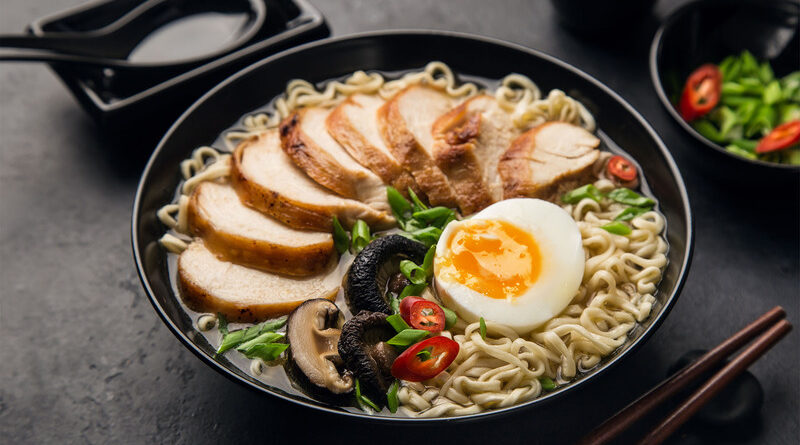The Ultimate Guide to Healthy Ramen Noodles: Elevate Your Bowl
A popular comfort dish, ramen noodles have historically been linked to convenience over health. However, a move toward mindfulness and fitness in eating has spurred enthusiasm for making this traditional dish a healthier option in recent years. This explores the world of healthy ramen noodles, looking at tasty broths, substitute ingredients, and clever cooking methods to improve flavor and nutritional content. Come along with us as we set out to reimagine ramen and make it a healthful and pleasant option for any mealtime.
Healthy Ramen Noodles Ingredients
| Ingredients | Quantity |
|---|---|
| Whole grain noodles | 2 servings |
| Homemade vegetable broth | 4 cups |
| Lean protein (e.g., grilled chicken breast, tofu, tempeh) | 6 ounces |
| Assorted vegetables (e.g., spinach, kale, carrots, mushrooms, bell peppers) | 2 cups, chopped |
| Aromatics (e.g., ginger, garlic, lemongrass) | 2 cloves garlic, minced 1-inch piece ginger, grated 1 stalk lemongrass, sliced |
| Low-sodium soy sauce or tamari | 2 tablespoons |
| Rice vinegar | 1 tablespoon |
| Honey | 1 tablespoon |
| Optional toppings (e.g., sliced scallions, cilantro, sesame seeds, nori seaweed) | As desired |
Tips for Making Healthy Ramen Noodles at Home
Making healthy ramen at home requires careful planning and thoughtful ingredient selection. Here are some important pointers to remember:
Control Portions:
To prevent overindulging, measure out the right portions of veggies, proteins, and healthy noodles.
Homemade Broths:
Use fresh ingredients when making homemade broths to minimize sodium and stay away from additives.
Whole Grain Noodles:
For more fiber and minerals, choose whole grain types.
Vegetable Variety:
Add more taste and nutrition to your ramen by adding a variety of vibrant healthy vegetables.
Lean Proteins:
Select low-fat options such as tofu or chicken breast to cut down on harmful fats.
Healthy Ramen Noodles Limit Added Fats:
Use cooking techniques that reduce the amount of added fat and select healthier oils sparingly.
Seasoning Control:
Pay attention to salt and seasonings; choose low-sodium substitutes and use them sparingly.
Garnish Wisely on Healthy Ramen Noodles:
Use seaweed, fresh herbs, or seeds to provide taste and visual appeal without adding too many calories.
The Health Risks of Traditional Ramen
Though tasty, traditional ramen has several health hazards because of its high sodium, refined carbohydrate, and saturated fat content. Frequent intake of traditional ramen has been linked to weight gain, higher blood pressure, and an increased risk of heart disease.
Furthermore, the deficiency of minerals in traditional ramen can lead to deficits and negatively impact general health. Making educated dietary decisions and looking into healthier ramen recipe substitutes require an understanding of these hazards.
Crafting Nutritious Broths for Ramen
Making a healthy broth is essential to improving the nutritional value of your ramen. Go for homemade broths that are full of herbs, veggies, and lean meats like turkey or chicken. Making your broth allows you to regulate the sodium level and stay away from hazardous ingredients that are added to store-bought varieties.
Try experimenting with different broth bases, such as chicken, miso, or vegetables, And add flavorful ingredients like dried mushrooms, ginger, and garlic to make them more aromatic. Your ramen will be tasty and healthful when it is made with a nutritious broth as the base.
Choosing Whole Grain Noodles for Health Benefits
With more fiber, vitamins, and minerals than regular refined noodles, whole-grain noodles are a healthier option. You can improve the nutritional value of your ramen dish by using whole grain noodles, Like whole wheat, brown rice, or buckwheat noodles.
Compared to processed noodles, whole grain noodles improve digestive health, control blood sugar, and increase feelings of fullness. Consider using whole-grain noodles instead of regular ones when making ramen at home for a more wholesome and nutritious option that will fill you up and nourish your body.
Incorporating Lean Proteins and Vegetables
Your ramen’s flavor and texture will be improved as well as its nutritional value by adding lean proteins and a variety of veggies. Seafood, tofu, and grilled chicken breast are examples of lean proteins that are high in nutrients but low in saturated fat.
In the meanwhile, a rainbow of veggies, including spinach, carrots, and mushrooms, contributes vitamins, antioxidants, and fiber. You can make a healthy, filling ramen that feeds the body and the soul by adding these nutritious ingredients to your dish.
Balancing Flavors and Healthy Ramen Noodles Seasonings
The secret to making a delicious bowl of ramen is striking a harmonic balance of ingredients. Add umami-rich ingredients to the broth, such as seaweed or dried mushrooms, to enhance its complexity. For depth, add pungent spices like ginger and garlic. To counterbalance the richness, add a tiny bit of acidity from components like rice vinegar.
To reduce the amount of salt, use tamari or low-sodium soy sauce. For a touch of sweetness, use honey or mirin. Finally, for a nice kick, don’t forget to add some chili oil or crushed red pepper flakes to spice things up. Your ramen will be a gourmet marvel that entices the senses with these flavor-enhancing tricks.
Conclusion
In conclusion, the transformation of ramen from a dish primarily focused on convenience to a healthier culinary alternative is indicative of a larger movement toward fitness and conscious eating. We’ve redesigned ramen as a tasty and nutritious lunch option by embracing homemade broths, whole grain noodles, lean proteins, and an abundance of vibrant vegetables.
By carefully measuring portions, selecting wise ingredients, and using inventive seasoning methods. We’ve elevated classic ramen to a dish that fulfills the needs of the body and the spirit. Anyone may prioritize their health and well-being while still enjoying the comfort and flavor of ramen by using these tactics.
